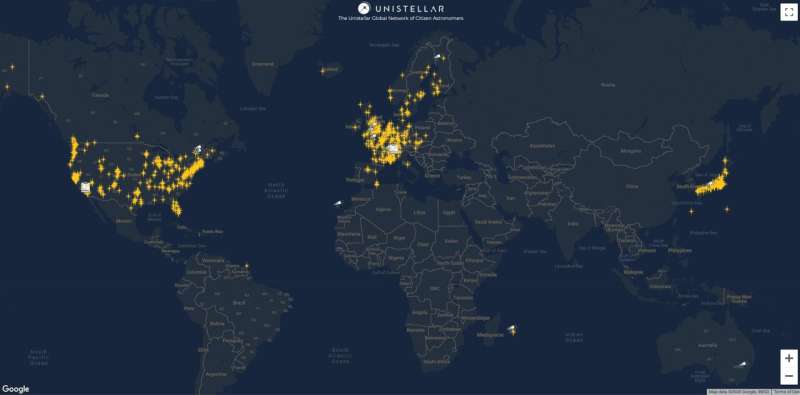Citizen astronomers reshape asteroids from their backyard

There are nearly one million catalogued asteroids, but we don't know much about many of them. Now Unistellar and its scientific partner, the SETI Institute, can count on a network of nearly 3,000 amateurs capable of observing thousands of asteroids and providing an estimate of their size and shape. With mobile stations located in Asia, North America and Europe, the Unistellar network, the largest network of citizen astronomers, participates in cutting-edge research and has delivered its first scientific results including the 3-D shape model of an asteroid and the size of another one.
"The Unistellar eVscope is more than a telescope. It's also a tool to access a network made of citizen astronomers throughout the world who can observe together and participate in scientific campaigns," said Franck Marchis, senior planetary astronomer at the SETI Institute and Chief Scientific Officer at Unistellar. "Today more than 150 people have already contributed to our campaigns and collected valuable scientific data from their backyard."
In addition to the SETI Institute, Marchis' group collaborated with Josef Hanuš and Josef Ďurech of the Institute of Astronomy at Charles University to identify potential targets of interest in the asteroid population. "After having designed and validated our data analysis pipeline in 2020, we can now routinely propose campaigns to our citizen astronomers," said Marchis.
Asteroid 943 Begonia: An occultation event
Although it was discovered in October of 1920, we don't know much about asteroid 943 Begonia's size. Inès Demuys, Unistellar Engineer, identified an occultation event by Begonia. An occultation is when a star temporarily disappears when an asteroid (or something else) passes in front of it. Two U.S.-based citizen astronomers, based in Arizona and in New York, detected the occultation with their eVscopes (Unistellar's digital telescope) in September of 2020. Analysis of the data they collected revealed that the main-belt asteroid could have a diameter of 83 km, making it 20% larger than previously known.
"The main difficulty of these kinds of observations is to be located in the right place and to observe at the right time," said Marchis. "Timing, good weather and a little luck are necessary. Fifty-three occultations campaigns were launched, leading to 10 positive detections, but as the process matures in the coming weeks, positive detections will indeed happen more often. Combined with an increasing number of observers we thus expect a growing number of evermore accurate scientific results.
Asteroid 787 Moskva: Lightcurve inversion
Another way to study asteroids is to measure the variation of light reflected due to their irregular shape. "Despite its relatively small aperture size, the eVscope is powerful enough to characterize around ~6,000 known asteroids in a year. SETI Institute Research Assistant Joé Asencio selected the main-belt asteroid 787 Moskva, which has an estimated diameter of 30 km. We asked our network to observe it for more than one hour in August 2020, and 7 citizen astronomers from 4 different countries, U.S., Finland, Switzerland, and France sent their observations," said Tom Esposito, an astronomer at the SETI Institute and UC Berkeley.
The flux variation over time, also called a lightcurve, showed the asteroid's spin and confirmed a spin period of 6.056 hours. Combining these new observations with previous ones, the team at Charles University found a new shape model of the asteroid, which is quite elongated and has a diameter between 25-30 km.
"This observation validates the use of the eVscope for accurate photometric studies, including transiting exoplanets, variable stars, supernovae and other transient events, significantly increasing the number of investigations possible with the Unistellar network," said Esposito.
Motivated by these recent results, the team is adding a new program in education and increasing the eVscope's network. "Education is one of the cornerstones of the SETI Institute's work and philosophy" says Simon Steel, Senior Director of Education and STEM Programs at the SETI Institute. "Unistellar technology is a powerful tool to engage and excite the next generation of astronomers, scientists and indeed anyone who has ever pondered the beauty of the night sky."
These findings will be presented at the 52nd Annual Meeting of the Division of Planetary Sciences of the American Astronomical Society.
More information: Session 413 Education and Community Engagement 2 Presentation. 413.02 First Results With a Network of Small Digital & Smart Telescopes: Citizen Science For Astronomy by Franck Marchis, SETI Institute & Unistellar on Thursday October 29.
Provided by SETI Institute





















